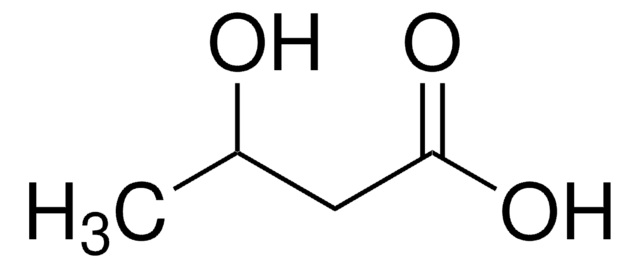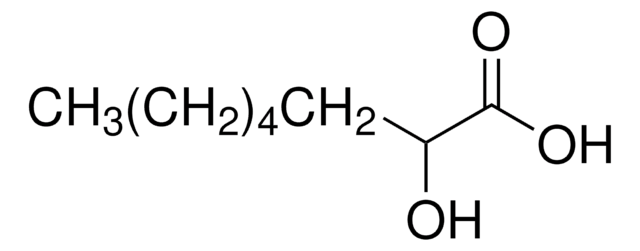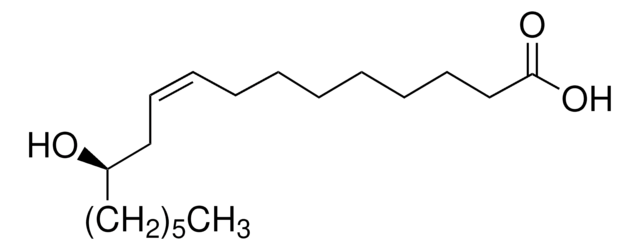H4148
DL-β-Hydroxymyristic acid
≥98%
Synonyme(s) :
3-Hydroxytetradecanoic acid
Se connecterpour consulter vos tarifs contractuels et ceux de votre entreprise/organisme
About This Item
Formule empirique (notation de Hill):
C14H28O3
Numéro CAS:
Poids moléculaire :
244.37
Numéro MDL:
Code UNSPSC :
12352211
ID de substance PubChem :
Nomenclature NACRES :
NA.25
Produits recommandés
Source biologique
synthetic (organic)
Niveau de qualité
Essai
≥98%
Forme
powder
Groupe fonctionnel
carboxylic acid
Type de lipide
saturated FAs
Conditions d'expédition
ambient
Température de stockage
2-8°C
Chaîne SMILES
CCCCCCCCCCCC(O)CC(O)=O
InChI
1S/C14H28O3/c1-2-3-4-5-6-7-8-9-10-11-13(15)12-14(16)17/h13,15H,2-12H2,1H3,(H,16,17)
Clé InChI
ATRNZOYKSNPPBF-UHFFFAOYSA-N
Catégories apparentées
Actions biochimiques/physiologiques
DL-β-Hydroxymyristic acid (3-HTA) is a mixture of D- and L-β-hydroxymyristic acid enantiomers. 3-Hydroxytetradecanoic acids are used to study their roles in biological processes such as oxidative stress, inflammation and insulin resistance. 3-HTA is also used in endotoxin and lipid A research.
Code de la classe de stockage
11 - Combustible Solids
Classe de danger pour l'eau (WGK)
WGK 3
Point d'éclair (°F)
Not applicable
Point d'éclair (°C)
Not applicable
Équipement de protection individuelle
Eyeshields, Gloves, type N95 (US)
Faites votre choix parmi les versions les plus récentes :
Déjà en possession de ce produit ?
Retrouvez la documentation relative aux produits que vous avez récemment achetés dans la Bibliothèque de documents.
Les clients ont également consulté
K Tanamoto
Advances in experimental medicine and biology, 256, 203-213 (1990-01-01)
New quantitative method for the detection of minute amounts of endotoxin has been developed using 3-hydroxytetradecanoic acid as a chemical marker. After converting 3-hydroxytetradecanoic acid to methyl ester, it was coupled with a fluorescent probe, anthracene-9-carboxyl chloride, obtained by chlorization
Pauline Grimm et al.
The British journal of nutrition, 123(4), 372-382 (2019-11-07)
Starchy diets can induce hindgut dysbiosis in horses. The present study evaluated the impact of a yeast (Saccharomyces cerevisiae) and microalgae (Aurantiochytrium limacinum) supplementation on caecal, colonic and faecal microbial ecosystem and on blood inflammatory parameters of horses fed high-fibre
Wenkuan Liu et al.
Applied microbiology and biotechnology, 76(5), 1153-1159 (2007-08-02)
Medium-chain-length polyhydroxyalkanoates (mcl-PHA) consisting of 3-hydroxyhexanoate (HHx), 3-hydroxyoctanoate (HO), 3-hydroxydecanoate, 3-hydroxydodecanoate, and high-content 3-hydroxytetradecanoate (HTD) was produced by knockout mutant Pseudomonas putida KT2442 termed P. putida KTOY06. When grown on 6 to14 g/L single-carbon-source tetradecanoic acid, P. putida KTOY06, which
A S Soydan et al.
Mediators of inflammation, 2006(5), 64980-64980 (2007-03-30)
Beta-hydroxy fatty acids are a major component of lipid A moiety of lipopolysaccharide. We aimed to investigate the role of free beta-hydroxy fatty acids on inflammation, as well as to evaluate their effects on cytokine release from human blood cells
Anelise M Tonin et al.
Neurochemistry international, 56(8), 930-936 (2010-04-13)
Accumulation of long-chain 3-hydroxy fatty acids is the biochemical hallmark of long-chain 3-hydroxyacyl-CoA dehydrogenase (LCHAD) and mitochondrial trifunctional protein (MTP) deficiencies. These disorders are clinically characterized by neurological symptoms, such as convulsions and lethargy, as well as by cardiomyopathy and
Notre équipe de scientifiques dispose d'une expérience dans tous les secteurs de la recherche, notamment en sciences de la vie, science des matériaux, synthèse chimique, chromatographie, analyse et dans de nombreux autres domaines..
Contacter notre Service technique












